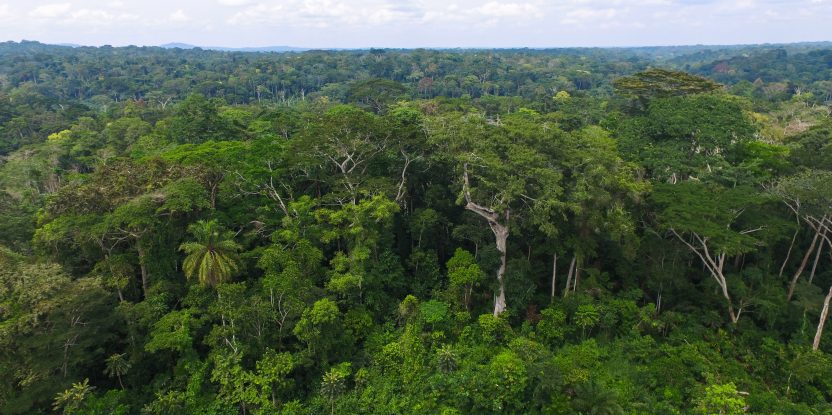
A new study has found that Central African moist forests and savannas acted as net carbon sinks from 2010 to 2019, absorbing more carbon than emitted during that time.
The research showed that rapid vegetation growth and recovery over the studied period counterbalanced the loss of aboveground biomass carbon (AGC) from deforestation, degradation, and soil and climate changes.
It’s good news for a region that plays a vital role in global terrestrial carbon cycles, but that is significantly impacted by human activities such as shifting cultivation, mining, and charcoal production.
The study highlighted the critical role of the region’s largely under-sung savannahs in its carbon dynamics. “When considering Central Africa’s ecosystems, most people tend to think solely of the Congo Basin rainforests,” said Denis Sonwa, the director of research, data and impact at the World Resources Institute Africa and a study co-author.
“But all ecosystems are important when we’re developing responses to climate change, and the findings of this research truly reflect that,” Sonwa continued. “It’s essential to recognize that Central Africa also hosts significant savannah ecosystems. These areas are crucial in carbon storage and biodiversity, and their health is as important as the forests.” Moreover, these ecosystems interact in ways we’re just beginning to understand. “Central Africa is a unique ecological region that requires a holistic approach to understanding biomass dynamics,” said Sonwa. “By viewing it as a block, we can better appreciate the interconnectedness of its ecosystems and the collective impact of human activities across borders.”
The study also spoke to forests’ resilience to human—and climate-induced stressors, which was shown through a high degree of natural regeneration that contributed to carbon absorption over the time period. However, the authors also noted that important discussions remain about which kinds of changes could create irreversible damage to the ecosystem.
“While carbon loss due to deforestation is counterbalanced at regional scale by the carbon gain due to forest growth and recovery in moist forests and savannas, the damage of deforestation and forest degradation to other ecosystem services needs to be factored in,” they wrote.
“For example, native forests provide better ecosystem service functions than restored forests and agroforestry systems, e.g. the protection of soil and water resources. Deforestation also leads to habitat loss of animals, from large mammals (forest elephants) to invertebrates, and, thus, biodiversity loss.”
Notably, radiation from the sun and vapour pressure deficit (VPD)—a measure of humidity—were found to be the most important non-deforestation factors affecting the region’s carbon stocks. This raises concerns about the effects that climate change could have on forests and trees’ ability to store and regulate greenhouse gases going forward.
Moreover, the authors noted that growing populations in the region—which are tipped to expand fivefold by 2100—will continue to intensify demand for natural resources. Reconciling conservation with economic development remains a key challenge in Central Africa, and solutions will need to be well-supported and context-specific, taking climatic changes and country-level policy conditions into account.
“Given the high conservation value and high carbon stock of forests in Central Africa, reconciling biodiversity conservation, carbon storage, and economic development will require careful management in this region and global support,” said the co-authors. Such support will likely come in the form of climate change mitigation initiatives such as REDD+.
“Because Central Africa serves as a vital carbon sink, the findings of this study can assist policymakers and conservationists in prioritizing areas for protection and restoration,” said Sonwa. “This, in turn, will contribute to global carbon reduction goals. Effective conservation strategies should include protecting high-carbon areas and restoring degraded lands, all within a well-designed framework of integrated sustainable land-use practices.”
Sonwa also noted the importance of multidisciplinary and inter-institutional collaboration and the deployment of geospatial tools like remote sensing in conjunction with granular, ground-level data in the research process. “When we’re searching for responses to climate change, we need to try as much as possible to work across different institutions and disciplines to capture some of the complexity that exists out there,” he said.
The study design also offers a promising pathway for scientists, practitioners, and policymakers seeking to understand carbon dynamics and their effects on ecosystems worldwide. “Biomass is a good common variable to monitor some of the ways that global climate change is impacting different ecosystems and landscapes, and thus guiding conservation efforts,” said Sonwa.
Acknowledgements
Denis J. Sonwa contributed to this paper while he was a senior scientist at CIFOR, with his work supported, among others, by CIFOR-ICRAF’s GCS REDD+ study, funded by NORAD. Denis has since transitioned to a new role as Director of Research Data and Impact (RDI) at WRI Africa.
We want you to share Forests News content, which is licensed under Creative Commons Attribution-NonCommercial-ShareAlike 4.0 International (CC BY-NC-SA 4.0). This means you are free to redistribute our material for non-commercial purposes. All we ask is that you give Forests News appropriate credit and link to the original Forests News content, indicate if changes were made, and distribute your contributions under the same Creative Commons license. You must notify Forests News if you repost, reprint or reuse our materials by contacting forestsnews@cifor-icraf.org.